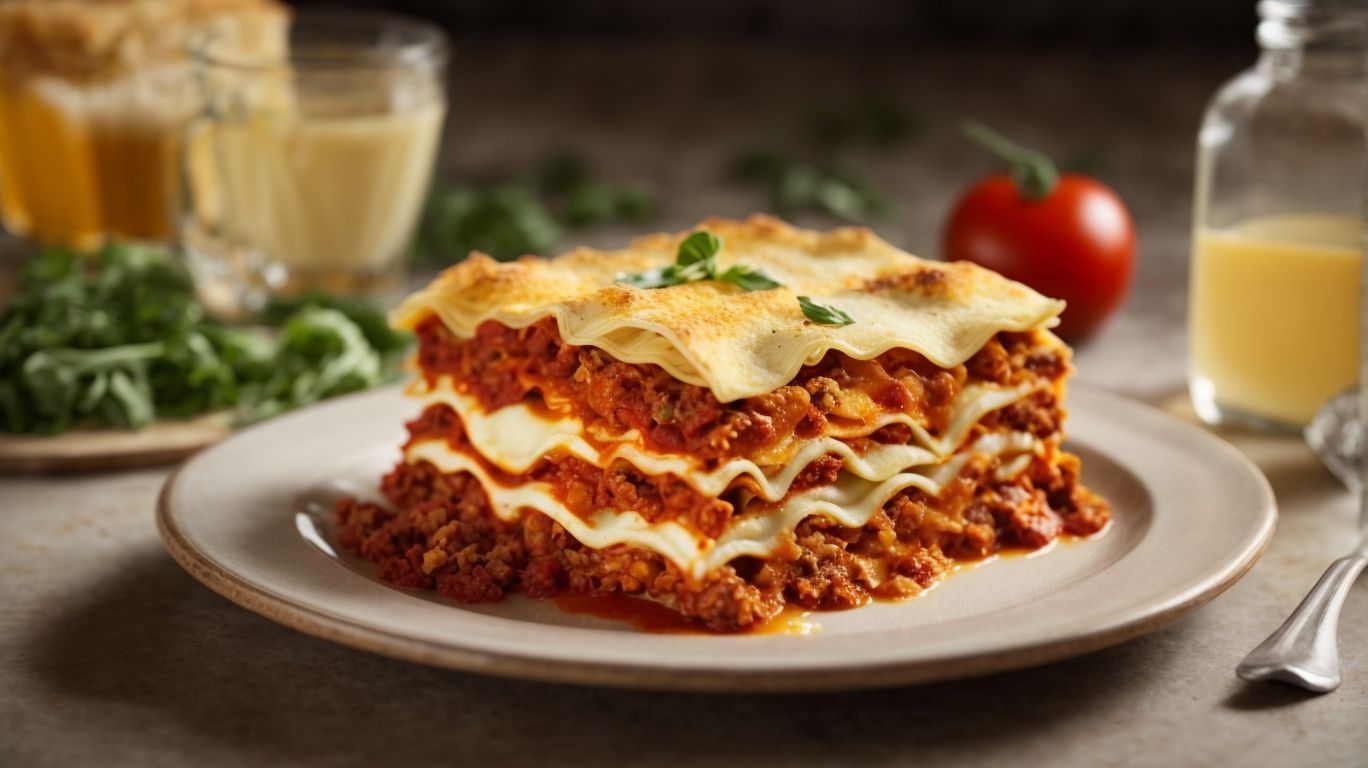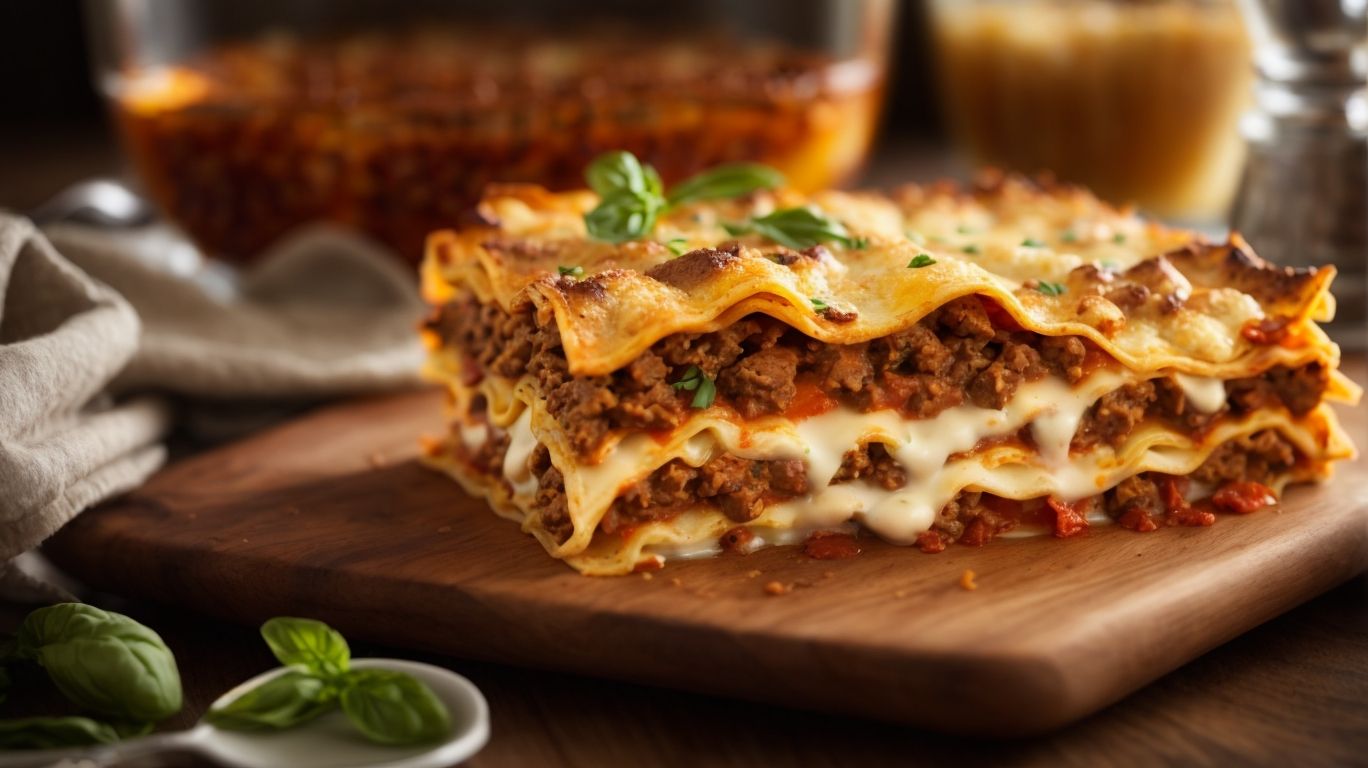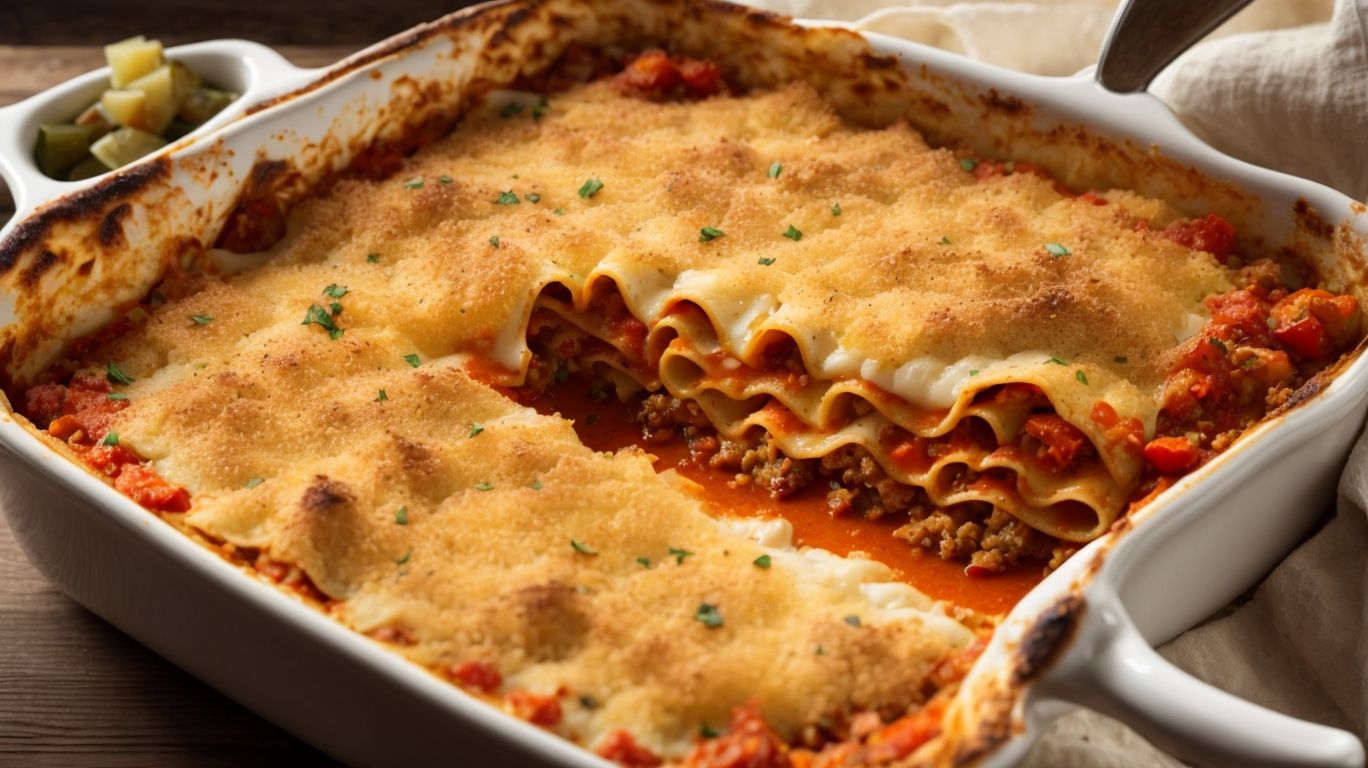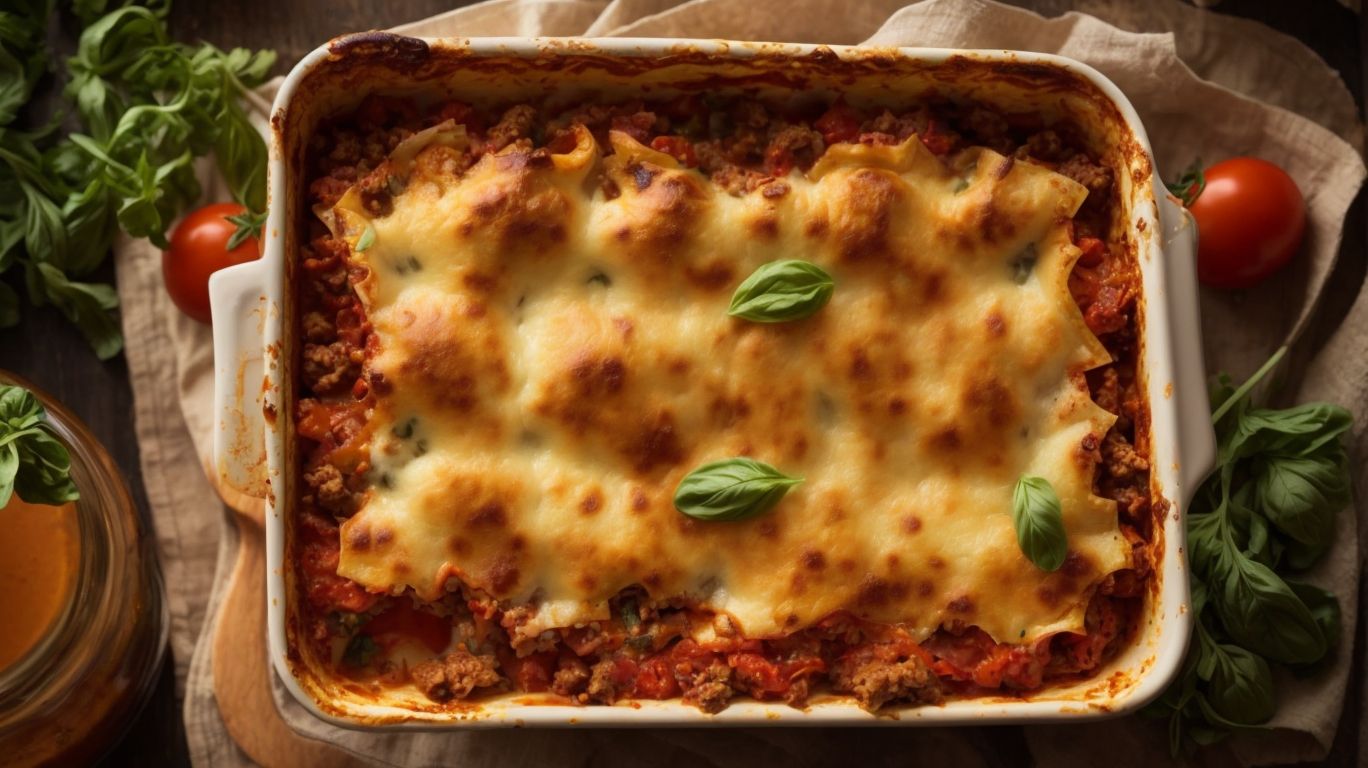How to Bake Lasagna Without Cheese?
Looking to bake a delicious lasagna without cheese? Whether due to dairy intolerance, following a vegan diet, or personal preference, there are plenty of tasty alternatives to cheese that can make your lasagna just as satisfying.
From using nutritional yeast to creating tofu ricotta, there are various ways to achieve that cheesy flavor without the dairy. In this article, we’ll explore how to make lasagna without cheese, including tips for baking and serving.
Let’s get started and create a mouthwatering dish that everyone can enjoy!
Key Takeaways:
Why Bake Lasagna Without Cheese?
Baking lasagna without cheese can be a beneficial choice for various reasons, including catering to dairy-free or vegan dietary preferences and offering a unique twist on a classic dish.
One of the advantages of opting for a cheese-free lasagna is the potential to reduce the overall calorie and fat content in the dish. By replacing cheese with alternative ingredients like cashew cream, tofu, or nutritional yeast, individuals can still create a rich and creamy texture without compromising on taste. Dairy-free variations can improve digestion for those with lactose intolerance or dairy sensitivities, making it a versatile and inclusive dish for gatherings or family meals.
Dairy Intolerance or Allergy
Individuals with dairy intolerance or allergies may opt for lasagna without cheese to enjoy a delicious and safe meal without compromising their health.
Choosing a cheese-free lasagna can be a smart choice for those who experience discomfort or allergic reactions after consuming dairy products. By eliminating cheese from the traditional lasagna recipe, they can savor a dish that is not only flavorful but also gentle on their digestive system.
It’s essential to prioritize one’s well-being and dietary needs to ensure a comfortable dining experience. Cheese-free lasagna allows individuals to indulge in a satisfying meal without the risk of triggering any adverse reactions related to their dairy intolerance or allergies.
Vegan or Plant-based Diet
Vegans or individuals following a plant-based diet often prefer lasagna without cheese as it aligns with their dietary choices and offers a cruelty-free alternative.
Plant-based diets have gained popularity for their focus on consuming whole foods derived from plants, providing a plethora of health benefits. By choosing cheese-free lasagna, vegans embrace ethical considerations, avoiding animal-derived products and supporting a sustainable lifestyle. Eliminating cheese from this traditional Italian dish not only reduces saturated fat intake but also encourages creativity in finding delightful substitutes.
The absence of cheese does not compromise the flavor; rather, it opens doors to explore diverse ingredients like tofu ricotta, cashew-based sauces, or nutritional yeast to achieve that creamy texture and cheesy taste. This adaptation of a classic recipe showcases the versatility and innovation inherent in vegan cooking, attracting those seeking delicious yet compassionate meals.
Personal Preference
Some individuals may simply enjoy the unique flavors and textures of lasagna without cheese, making it a personal preference rather than a dietary necessity.
When opting for cheese-free lasagna, one can truly savor the rich tomato sauce blending with the savory herbs and spices, creating a symphony of flavors that dance on the taste buds.
The absence of cheese allows the other ingredients, such as the layers of tender noodles and hearty vegetable or meat fillings, to shine through, adding depth and complexity to each bite.
For those with a preference for a lighter, fresher lasagna experience, omitting cheese can enhance the overall dish, providing a satisfying meal that is both comforting and wholesome.
What are the Alternatives to Cheese in Lasagna?

Credits: Poormet.Com – Edward Nelson
When preparing lasagna without cheese, several delicious alternatives can be used, such as vegan ricotta, cashew cream, or flavorful hummus.
Vegan ricotta is a popular dairy-free option that mimics the creamy texture and mild flavor of traditional ricotta, making it a versatile choice in lasagna recipes.
Cashew cream, made from soaked cashews blended with water, offers a rich and velvety consistency, adding a luxurious touch to the dish.
On the other hand, hummus brings a unique savory taste with a hint of garlic and tanginess, perfect for those looking to experiment with bold flavors in their lasagna.
Nutritional Yeast
Nutritional yeast is a popular cheese alternative in vegan lasagna recipes, providing a savory, cheesy flavor without dairy products.
One of the key advantages of using nutritional yeast in vegan lasagna is its umami-rich flavor that closely mimics the taste of cheese, making it a versatile ingredient in plant-based cooking. Nutritional yeast is not only prized for its taste but also for its nutritional profile, being a good source of B vitamins, including B12, which is essential for individuals following a vegan diet.
This dairy-free ingredient adds a creamy texture when mixed with plant-based milk or sauces, creating a luscious lasagna filling that is both flavorful and nutritious. Whether sprinkled on top for a cheesy finish or blended into a cheesy sauce, nutritional yeast elevates the dish with its unique cheesy notes.
Tofu Ricotta
Tofu ricotta is a creamy and protein-rich alternative to traditional cheese fillings in lasagna, offering a vegan-friendly option for dairy-free dishes.
Its smooth and velvety texture mimics the richness of dairy-based ricotta, making it a versatile ingredient for various recipes beyond lasagna, such as stuffed shells, ravioli, and even desserts like cheesecake.
Not only is tofu ricotta delicious, but it also packs a punch in terms of nutritional value, being low in saturated fat and cholesterol-free, making it a heart-healthy choice for those looking to reduce their intake of animal products.
For those following a vegan or plant-based diet, tofu ricotta is a great source of plant-based protein and essential nutrients, including calcium, iron, and magnesium, helping to support overall health and well-being.
Cashew Cream
Creamy cashew cream can add richness and depth to lasagna recipes, serving as a luscious replacement for traditional cheese layers.
When blended to a velvety consistency, cashew cream offers a luxurious mouthfeel that complements the savory layers of lasagna perfectly. Its nutty undertones bring a unique flavor profile that enhances the overall taste experience, making each bite a delightful indulgence. The versatility of cashew cream extends beyond lasagna, making it a staple in various vegan and dairy-free dishes such as creamy pasta sauces, dips, and desserts. The ease of preparation and adaptability of this plant-based alternative opens up a world of culinary possibilities, allowing for creativity in dairy-free cooking while maintaining a satisfying creaminess.
Hummus
Hummus can be a flavorful and protein-packed addition to lasagna, offering a unique twist and Mediterranean-inspired taste to cheese-free recipes.
Its creamy texture and nutty undertones complement traditional lasagna ingredients such as roasted vegetables, fresh herbs, and tangy tomato sauce.
Rich in plant-based protein, fiber, and healthy fats, hummus enhances the nutritional profile of the dish, making it a satisfying and wholesome option for vegetarians and vegans.
Incorporating Mediterranean flavors like garlic, lemon, and tahini, hummus introduces a depth of umami and a hint of zest that elevate the overall taste of the lasagna.
How to Make Lasagna Without Cheese?

Credits: Poormet.Com – Joshua Young
Creating a delicious lasagna without cheese involves preparing flavorful components such as lasagna noodles, rich tomato sauce, and melty vegan mozzarella for a satisfying plant-based meal.
Start by boiling lasagna noodles according to the package instructions until they are al dente. This step is crucial as it forms the structural foundation of your lasagna.
Simultaneously, in a saucepan, sauté minced garlic and onions in olive oil until they are soft and fragrant. Add canned tomatoes, tomato paste, basil, oregano, salt, and a pinch of sugar to create a rich tomato sauce. Let it simmer and develop flavors.
For a cheesy topping, opt for vegan mozzarella shreds or a homemade cashew-based ricotta. These dairy-free alternatives can provide the creamy texture and oozy finish that a traditional cheese would offer.
When all components are ready, it’s time to assemble your lasagna. Start by spreading a layer of tomato sauce at the bottom of your baking dish. Then, place a layer of cooked noodles followed by a generous sprinkle of vegan cheese substitute. Repeat this process for 2-3 layers.
Prepare the Lasagna Noodles
Begin by cooking the lasagna noodles to al dente perfection, ensuring they are firm yet tender for layering in the dish.
When boiling the noodles, be sure to generously salt the water to infuse them with flavor. Stir occasionally to prevent sticking, but avoid overcrowding the pot to ensure even cooking. Once they reach the desired texture, promptly drain and rinse them with cold water to halt the cooking process and prevent them from becoming mushy.
For those who enjoy a slightly firmer bite, opt for a shorter cooking time, whereas if you prefer a softer texture, extend the cooking time slightly. Remember that the noodles will continue to cook in the oven, so it’s crucial not to overcook them initially.
Make the Tomato Sauce
Craft a robust and flavorful tomato sauce by sautéing garlic, simmering ripe tomatoes, and seasoning with aromatic herbs for a zesty lasagna base.
To begin, select fresh, ripe tomatoes for the sauce as they will provide the best flavor. Chop the tomatoes into small pieces after removing the core and seeds. In a large saucepan, heat olive oil over medium heat and add minced garlic, sautéing until fragrant.
Next, add the chopped tomatoes to the pan and let them simmer gently, allowing the flavors to meld together. Stir occasionally to prevent sticking and reduce the liquid content to achieve a thick, rich consistency.
Enhance the flavor profile by adding a sprinkle of salt and pepper, along with a couple of whole bay leaves and a pinch of red pepper flakes for a subtle kick. For a touch of sweetness, consider incorporating a teaspoon of sugar or a splash of balsamic vinegar.
Create the Cheese Substitute
Prepare a creamy and melty vegan mozzarella substitute by blending cashews, nutritional yeast, and seasonings for a decadent layer in your cheese-free lasagna.
For a tangier flavor profile, you can add a squeeze of lemon juice or a dash of apple cider vinegar to the mixture. Achieving the right consistency is key, so adjust the amount of liquid (such as water or plant-based milk) to reach the desired creaminess.
Experiment with different herbs and spices like garlic powder, onion powder, or smoked paprika to enhance the overall taste of your vegan cheese. If you prefer a stretchier texture, try incorporating tapioca starch or agar agar into the recipe.
When layering your lasagna, make sure to spread the vegan mozzarella substitute evenly to ensure a gooey, melted finish. Bake your lasagna until the cheese substitute has melted and slightly browned, creating a mouthwatering, dairy-free dish that is sure to impress!
Assemble the Lasagna
Layer lasagna noodles with rich tomato sauce, savory vegan ricotta, sautéed mushrooms, and wilted spinach for a decadent and satisfying cheese-free lasagna.
Building a truly delicious cheese-free lasagna requires attention to detail and layering the ingredients in the right order. The key is to achieve a harmonious blend of flavors and textures throughout the dish. Start by spreading a generous layer of rich tomato sauce on the bottom of the baking dish to ensure that the noodles cook evenly and absorb the flavors well. Next, add dollops of creamy vegan ricotta, made from a blend of tofu, nutritional yeast, and seasonings, creating a smooth and indulgent layer.
As you move on to the next layer, sautéed mushrooms come into play, providing a hearty and earthy element to the lasagna. Make sure to season them well with garlic, herbs, and a touch of balsamic vinegar for depth of flavor. Then, add a layer of wilted spinach, which brings a bright freshness and a nutritional boost to the dish.
Baking and Serving Tips
For optimal results, cover your lasagna with foil during baking to retain moisture, allow it to rest before serving to enhance flavors, and garnish with fresh herbs for a vibrant presentation.
When selecting a pasta sauce for your lasagna, opt for rich and robust flavors such as marinara or bolognese to complement the layers of pasta and cheese.
- For meat options, consider using a combination of ground beef and Italian sausage for a savory depth of flavor.
- Layer your lasagna generously with cheese such as mozzarella, ricotta, and Parmesan to achieve a decadent and creamy texture.
Remember to let your lasagna cool slightly post-baking to facilitate neat slices and prevent it from falling apart when served.
Cover with Foil
Ensure your lasagna stays moist and cooks evenly by covering it with foil during the initial baking process, allowing the flavors to meld and intensify within the layers.
Using foil to cover your lasagna serves multiple crucial purposes beyond just retaining moisture. The foil acts as a protective barrier, preventing excessive evaporation of the sauces and liquids within the dish, ensuring that each bite remains rich and succulent. By trapping the steam that is naturally released during the cooking process, the foil aids in flavor infusion, allowing the various ingredients and seasonings to meld together harmoniously.
By regulating the internal temperature of the dish, the foil helps prevent excessive browning or drying out of the top layer, ensuring that your lasagna cooks uniformly from edge to edge. This method creates a perfect environment for the pasta to cook al dente, the cheeses to melt into gooey perfection, and the sauces to blend into a heavenly amalgamation of flavors and textures.
Let it Rest Before Serving
Allow your freshly baked lasagna to rest for a few minutes before serving, enabling the layers to set and the flavors to meld, creating a harmonious dining experience with each bite.
Letting your lasagna rest after baking is a crucial step in the cooking process. During this resting period, the dish continues to cook gently due to the retained heat, ensuring that the flavors intensify and distribute evenly throughout the layers. This resting time allows the bubbling hot sauce to thicken slightly, enhancing the overall texture and making it easier to slice into neat portions.
Resting period also helps in firming up the lasagna structure, making it less likely to fall apart when served, preserving the intricate layers of pasta, cheese, and savory ground beef. Allowing the dish to rest before serving gives you the opportunity to present it at the perfect temperature, ensuring that each guest enjoys a delicious and satisfying meal.
Garnish with Fresh Herbs
Elevate the presentation and flavor profile of your lasagna by garnishing it with fragrant fresh herbs, such as basil or parsley, adding a burst of color and freshness to each serving.
In terms of enhancing the visual appeal of your lasagna, a sprinkle of vibrant green herbs on top not only adds a pop of color but also elevates the overall aesthetic of the dish. The aromatic enhancements provided by the fresh basil or parsley not only create an inviting scent but also awaken the taste buds even before the first bite. Incorporating pesto sauce as a base layer before adding the herbs can further intensify the herbaceous notes in each mouthful, creating a harmonious blend of flavors.
Conclusion

Credits: Poormet.Com – Jason Thomas
Creating lasagna without cheese opens up a world of possibilities for dairy-free and vegan culinary adventures, offering a delicious and inclusive alternative for all to enjoy.
One of the main benefits of cheese-free lasagna is its versatility in accommodating various dietary preferences. By skipping the cheese, this dish becomes suitable for lactose intolerant individuals, those with dairy allergies, and vegans. This plant-based version of lasagna allows for a diverse range of ingredients to shine, such as roasted vegetables, flavorful tomato sauces, and protein-packed tofu or plant-based meat substitutes.
Cheese-free lasagna provides a lighter option compared to traditional versions, making it a healthier choice for those looking to reduce their saturated fat intake. This variation showcases the natural flavors of the ingredients and allows for different seasoning combinations to truly elevate the dish.
Frequently Asked Questions
1. Can I make lasagna without using cheese?
Yes, it is possible to make lasagna without using cheese. There are many delicious alternatives to traditional cheese, such as using a dairy-free cheese substitute or adding extra layers of vegetables.
2. How do I substitute cheese in a lasagna recipe?
You can substitute cheese in a lasagna recipe by using a dairy-free cheese substitute, such as tofu or cashew-based cheese. You can also use extra layers of vegetables, such as zucchini, eggplant, or spinach.
3. What are some alternatives to cheese in a lasagna?
There are many delicious alternatives to cheese in a lasagna, including dairy-free cheese substitutes, such as tofu or cashew-based cheese. You can also add extra layers of vegetables, such as zucchini, eggplant, or spinach.
4. How can I make a vegan lasagna without cheese?
To make a vegan lasagna without cheese, you can use a vegan cheese substitute or add extra layers of vegetables. You can also make a creamy, dairy-free sauce using cashews or tofu.
5. Is it possible to make a gluten-free lasagna without cheese?
Yes, it is possible to make a gluten-free lasagna without cheese. You can use gluten-free lasagna noodles and substitute cheese with a dairy-free alternative or extra layers of vegetables.
6. Can I still make a delicious lasagna without using cheese?
Absolutely! There are many great alternatives to cheese that can still make a delicious lasagna. Experiment with different dairy-free cheese substitutes or add extra layers of vegetables for a tasty and healthy option.

